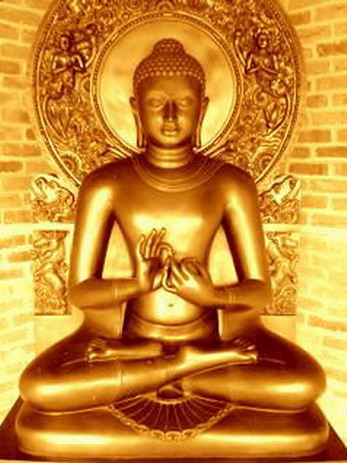
Buddha's original name was Siddhartha. It meant one who had accomplished his aim. Gautama was Siddhartha's family name. Siddhartha was known all over the world as Buddha, the Enlightened. He was also known by the name of Sakhya Muni, which meant an ascetic of the Sakhya tribe. The Buddha who is the founder of the Buddhist religion is called Buddha Shakyamuni. "Shakya" is the name of the royal family into which he was born, and "Muni" means "Able One." Buddha Skakyamuni was born as a royal prince in 624 BC in a place called Lumbini, which was originally in northern India but is now part of Nepal. His mother's name was Queen Mayadevi and his father's name was King Shuddhodana. Siddhartha spent his boyhood at Kapilavastu and its vicinity. He was married at the age of sixteen. His wife's name was Yasodhara. Siddhartha had a son named Rahula.
At the age of twenty-nine, Siddhartha Gautama suddenly abandoned his home to devote himself entirely to spiritual pursuits and Yogic practices. A mere accident turned him to the path of renunciation. One day he managed, somehow or the other, to get out of the walled enclosure of the palace and roamed about in the town along with his servant Channa to see how the people were getting on. The sight of a decrepit old man, a sick man, a corpse and a monk finally induced Siddhartha to renounce the world. He felt that he also would become a prey to old age, disease and death. Also, he noticed the serenity and the dynamic personality of the monk. Let me go beyond the miseries of this Samsara (worldly life) by renouncing this world of miseries and sorrows. This mundane life, with all its luxuries and comforts, is absolutely worthless. I also am subject to decay and am not free from the effect of old age. Worldly happiness is transitory".
Gautama left for ever his home, wealth, dominion, power, father, wife and the only child. He shaved his head and put on yellow robes. He marched towards Rajgriha, the capital of the kingdom of Magadha. There were many caves in the neighboring hills. Many hermits lived in those caves. Siddhartha took Alamo Kalamo, a hermit, as his first teacher. He was not satisfied with his instructions. He left him and sought the help of another recluse named Uddako Ramputto for spiritual instructions. At last he determined to undertake Yogic practices. He practiced severe Tapas (austerities) and Pranayama (practice of breath control) for six years. He determined to attain the supreme peace by practicing self-mortification. He abstained almost entirely from taking food. He did not find much progress by adopting this method. He was reduced to a skeleton. He became exceedingly weak.
Buddha's Teachings - According to Buddha "Dharma" means "protection". By practicing Buddha's teachings we protect our self from suffering and problems. All the problems we experience during daily life originate from ignorance, and the method for eliminating ignorance is to practice Dharma.
Practicing Dharma is the supreme method for improving the quality of our human life. The quality of life depends not upon external development or material progress, but upon the inner development of peace and happiness. For example, in the past many Buddhists lived in poor and underdeveloped countries, but they were able to find pure, lasting happiness by practicing what Buddha had taught.
No comments:
Post a Comment